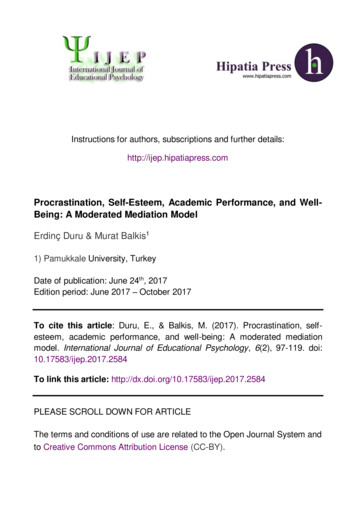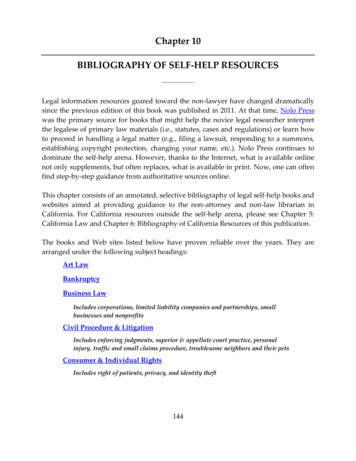
Transcription
February 24, 2013 at 3:29 PM452 chapter 08.docxpage 1 of 54CHAPTER 8SELF-ESTEEMI.WHAT IS SELF-ESTEEM? . 3A.B.II.THE NATURE AND ORIGINS OF SELF-ESTEEM . 8A.B.C.III.AFFECTIVE MODELS OF SELF-ESTEEM .9COGNITIVE MODELS OF SELF-ESTEEM .12SOCIOLOGICAL MODELS OF SELF-ESTEEM.19SELF-ESTEEM AND RESPONSES TO EVALUATIVE FEEDBACK . 22A.B.C.D.E.IV.THREE MEANINGS OF SELF-ESTEEM .3MEASURING SELF-ESTEEM .5EMOTIONAL RESPONSES TO FAILURE .23COGNITIVE RESPONSES TO FAILURE .25BEHAVIORAL RESPONSES TO FAILURE .27THEORETICAL EXPLANATIONS .30THEORETICAL MODELS OF SELF-PROTECTION .32IMPLICATIONS AND REFLECTIONS . 33A.B.C.SELF-ENHANCEMENT AND SELF-CONSISTENCY .33GLOBAL SELF-ESTEEM AND SPECIFIC SELF-EVALUATIONS.34A PERSONAL NOTE: SOME THOUGHTS ABOUT FEELINGS .35V.CHAPTER SUMMARY . 40VI.FOR FURTHER READING . 42VII. REFERENCES . 43
February 24, 2013 at 3:29 PM452 chapter 08.docxpage 2 of 54CHAPTER 8SELF-ESTEEMSelf-esteem is the panacea of modern life. It is seen as the key to financial success,health, and personal fulfillment, and it is regarded as the antidote to underachievement,crime, and drug abuse (Branden, 1994; Mecca, Smelser, & Vasconcellos, 1989). Self-esteemis also popular in academic circles. In the fields of personality and social psychology, it hasbeen implicated in models of conformity (Brockner, 1984), attraction (Hatfield, 1965),persuasion (Rhodes & Wood, 1992), cognitive dissonance (Steele, Spencer, & Lynch, 1993),subjective well-being (Diener & Diener, 1995), and social comparison processes (Aspinwall& Taylor, 1993; Gibbons & Gerrard, 1991; Wood, Giordano-Beech, Taylor, Michela, & Gaus,1994), just to name a few.The widespread appeal of self-esteem attests to its importance, but this popularityhas had an undesirable consequence. Self-esteem is currently spread so thin that it isdifficult to know just what it is. It is used as a predictor variable (some researchers studywhether high self-esteem people think, feel, and behave differently than low self-esteempeople), an outcome variable (some researchers study how various experiences affect theway people feel about themselves), and a mediating variable (the need for high self-esteemis presumed to motivate a wide variety of psychological processes). In short, self-esteemhas become a protean concept—so capable of changing form that its value is in risk ofbeing undermined.In this chapter we will critically review the nature, origins, and functions of selfesteem. The chapter begins by considering the nature of self-esteem. Here we ask: What dowe mean by the term “self-esteem,” and what characteristics are associated with high selfesteem and with low self-esteem? Next we examine the genesis of self-esteem. Our concernhere will be with understanding what experiences give rise to high self-esteem and to lowself-esteem. We will then consider when self-esteem is important. Here we will ask: Whatdifference does it make whether a person has high self-esteem or low self-esteem? Finally,we will consider some unresolved controversies in the field.A central issue guiding our discussion will involve the nature of self- esteem itself.Some psychologists (myself included) adopt an affective approach to understanding thenature of self-esteem. This approach asserts that self-esteem is a feeling of affection foroneself that develops largely through visceral or irrational processes (irrational in this casemeans “not based in logic”). Other psychologists take a more cognitive view. They believethat self-esteem is a judgment people make about themselves. This judgment is largelybased on an assessment of one’s various abilities and attributes. Whereas the formerapproach likens self-esteem to feelings of love (which typically are not rational or logical),the latter likens self-esteem to a decision people make about their worth and value as aperson. Although not all theories fall neatly into one camp or the other, keeping this affect–cognition distinction in mind will help you organize the material that follows.One more word before we begin. Self-esteem has been implicated in manypsychological phenomena of a clinical nature (e.g., anxiety, depression, eating disorders,and substance abuse) (for a review, see Robson, 1988). Issues of this nature will be
February 24, 2013 at 3:29 PM452 chapter 08.docxpage 3 of 54discussed in Chapter 9. The current chapter will focus on self-esteem within normal (i.e.,nonclinical) populations.I.What is Self-Esteem?Self-esteem is part of everyday language, and at an intuitive level, everyone seems toknow what self-esteem “is.” It may surprise you then to know that there is less than perfectagreement within the psychological literature. Part of the problem is that the term is usedin three different ways.A.Three Meanings of Self-Esteem1.Global Self-EsteemMost often, the term “self-esteem” is used to refer to a personality variable thatcaptures the way people generally feel about themselves. Researchers call this form of selfesteem global self-esteem or trait self-esteem, as it is relatively enduring, both across timeand situations. In this book, I have used the term self-esteem (without any qualifiers) whenreferring to this variable.Attempts to define self-esteem have ranged from an emphasis on primitive libidinalimpulses (Kernberg, 1975), to the perception that one is a valuable member of ameaningful universe (Solomon, Greenberg, & Pyszczynski, 1991). I take a decidedly lessexotic approach and define self-esteem in terms of feelings of affection for oneself (Brown,1993; Brown & Dutton, 1995b). Within normal populations, high self-esteem ischaracterized by a general fondness or love for oneself; low self-esteem is characterized bymildly positive or ambivalent feelings toward oneself. In extreme cases, low self-esteempeople hate themselves, but this kind of self-loathing occurs in clinical populations, not innormal populations (Baumeister, Tice, & Hutton, 1989).2.Self-EvaluationsThe term self-esteem is also used to refer to the way people evaluate their variousabilities and attributes. For example, a person who doubts his ability in school is sometimessaid to have low academic self-esteem, and a person who thinks she is popular and wellliked is said to have high social self- esteem. In a similar vein, people speak of having highself-esteem at work or low self-esteem in sports. The terms self-confidence and selfefficacy have also been used to refer to these beliefs, and many people equate selfconfidence with self-esteem. I prefer to call these beliefs self-evaluations or self-appraisals,as they refer to the way people evaluate or appraise their abilities and personalitycharacteristics.Self-esteem and self-evaluations are related—people with high self-esteem thinkthey have many more positive qualities than do people with low self- esteem—but they arenot the same thing. A person who lacks confidence in school might still like himself a lot.Conversely, a person who thinks she is attractive and popular might not feel good aboutherself at all. Unfortunately, psychologists don’t always make this distinction, often usingthe terms self- esteem and self-evaluations interchangeably.The causal association between self-esteem and self-evaluations is also unclear.Cognitive models of self-esteem assume a bottom-up process (e.g., Harter, 1986; Marsh,
February 24, 2013 at 3:29 PM452 chapter 08.docxpage 4 of 541990; Pelham & Swann, 1989). They assume that positive evaluations of self in particulardomains give rise to high self-esteem. I call this a bottom-up process because it assumesthat global self-esteem is built up from these more specific evaluations. Affective models ofself-esteem assume a top-down process (Brown, 1993; Brown, Dutton, & Cook, 1997).These models assume that the causal arrow goes from global self-esteem to specific selfevaluations: Liking oneself in a general way leads people to believe they have manypositive qualities. Later in this chapter we will examine support for these claims.3.Feelings of Self-WorthFinally, the term self-esteem is used to refer to rather momentary emotional states,particularly those that arise from a positive or negative outcome. This is what people meanwhen they speak of experiences that bolster their self-esteem or threaten their self-esteem.For example, a person might say her self-esteem was sky-high after getting a bigpromotion, or a person might say his self-esteem was really low after a divorce. FollowingWilliam James (1890), we will refer to these emotions as self-feelings or as feelings of selfworth. Feeling proud or pleased with ourselves (on the positive side), or humiliated andashamed of ourselves (on the negative side) are examples of what we mean by feelings ofself-worth.Because they involve feelings toward oneself, some researchers (e.g., Butler,Hokanson, & Flynn, 1994; Leary, Tambor, Terdal, & Downs, 1995) use the term state selfesteem to refer to the emotions we are calling feelings of self-worth, and trait self-esteemto refer to the way people generally feel about themselves. These terms connote anequivalency between the two phenomena, implying that the essential difference is simplythat global self-esteem is persistent, while feelings of self-worth are temporary.The trait–state assumption has important consequences. First, it suggests thatfeeling proud of oneself is akin to having high self-esteem and that feeling ashamed ofoneself is akin to having low self-esteem. This, in turn, leads investigators to assume that ananalogue of high self-esteem or low self-esteem can be created by temporarily leadingpeople to feel good or bad about themselves (e.g., Greenberg et al., 1992; Heatherton &Polivy, 1991; Leary et al., 1995). This is typically accomplished by giving people positive ornegative self-relevant feedback (e.g., telling people they are high or low in some ability).Other researchers disagree with this approach, arguing that these manipulations do notprovide a suitable analogue of high self-esteem or low self- esteem (Brown & Dutton,1995b; Wells & Marwell, 1976).One more point about feelings of self-worth. Several times in this book we havespoken of a basic human need to feel good about ourselves. Within psychology, this iscalled the self-enhancement motive. This term refers to the fact that people are motivatedto have high feelings of self-worth. People want to feel proud of themselves rather thanashamed of themselves. They strive to maximize and protect their feelings of self-worth.The way people go about trying to meet this need differs across time, cultures, andsubcultures, but the need is universal. The conclusion was perhaps best stated by thePulitzer Prize-winning anthropologist Ernest Becker, who wrote:The fundamental datum for our science is a fact that at first seems banal, orirrelevant: it is the fact that—as far as we can tell—all organisms like to “feel
February 24, 2013 at 3:29 PM452 chapter 08.docxpage 5 of 54good” about themselves. . . . Thus in the most brief and direct manner, wehave a law of human development. . . . (Becker, 1968, p.328)Interestingly, there is no consensus on why people are motivated to have positivefeelings of self-worth. Some believe these feelings are intrinsically satisfying; as James (1890)put it, “direct and elementary endowments of our nature” (1890, p.306). Others (Gergen, 1971;Kaplan, 1975) believe that positive feelings of self-worth are preferred simply because theyhave come to be associated with positive outcomes, such as praise from others or success. Stillothers believe that feelings of self-worth are desired because they imbue life with meaning andmake one’s inevitable death more tolerable (Greenberg et al., 1992). Whatever the source of thisneed may be, a desire to promote, maintain, and protect positive feelings of self-worth has beenassumed to motivate a wide range of human behavior. This includes behavior in achievementsettings (Covington & Berry, 1976), social settings (Tesser, 1988), and health settings (Ditto &Lopez, 1992).B.Measuring Self-EsteemNow that we have some idea of
self-esteem assume a top-down process (Brown, 1993; Brown, Dutton, & Cook, 1997). These models assume that the causal arrow goes from global self-esteem to specific self- evaluations: Liking oneself in a general way leads people to believe they have many positive qualities. Later in this chapter we will examine support for these claims. 3. Feelings of Self-Worth Finally, the term self-esteem .










